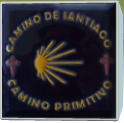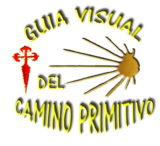

THE SIGNS


GUÍA VISUAL DEL CAMINO PRIMITIVO
It is very important to understand the meaning of the signs that will guide you along The
Way
Please, read this section thoroughly if it is the first time you do this Way.
There are only two signs you should pay attention to:
1.The Shell
2.The Arrow
In
theory,
there
shouldn’t
be
any
difficulty
in
following
these
two
signs,
but
the
real
problem
is
the
wide
variety
of
positions
The
Shell
might
have
and
its
combination
with
The
Arrow,
which may lead to confusion.
In Asturias
It is generally known -piece of information explained in paperback guides- that the
narrowest part of The Shell is the one that will guide you until the city of the apostle.
This would be its position
All the boundary markers in Asturias are very old and maintain the marked position of the
Concha throughout their entire route through these lands. You'll see a yellow arrow painted
in random order on many of them.
In Asturias, you'll see a variety of markers for the path to follow.
• Markers with just the shell.
• Markers with the shell and an arrow painted on the body of the marker.
• Markers with a shell and a small arrow attached next to it.
• Solitary shells where you least expect them.
• Yellow arrows painted everywhere.
• You'll also find posts containing a shell and arrow combination (follow the arrow).
In Galicia
It
is
commonly
known,
especially
in
outdated
paper
guidebooks,
that
the
position
of
the
Concha
in
this
community
is
that
the
widest
part
of
the
Concha
indicates
the
direction
to
follow toward the city of the Apostle. This concept has now been superseded.
In
Galicia
,
signage
is
currently
uniform.
From
the
moment
you
enter
Alto
del
Acebo,
heading
toward
Fonsagrada,
you'll
find
cairns
on
both
sides
of
the
Camino
every
250
meters.
You
should
note
that
the
markers
and
signs
(plaques
with
an
arrow
underneath)
that
you
find
on
the
left
side
of
the
path
you
are
on
have
the
shell
oriented
one
way
and
those
on
the
right
side
another.
But
they
will
always
be
the
same
on
each
side
of
the
road
where
they
are, whether it is the left side or the right side.
In
Galicia,
following
specific
regulations
adopted
in
2018
by
the
Camino
de
Santiago
Council,
they
have
been
posting
signs
for
several
years
following
the
criteria
they
hope
to
adopt
in
all
the
Autonomous
Communities
where
the
various
official
routes
pass.
This
consists
of
a
marker
with
the
Concha,
a
yellow
arrow,
the
remaining
kilometers
to
Santiago, and the name of the Autonomous Community through which the Camino passes.
Therefore,
when
you
see
a
milestone,
look
for
the
arrow
engraved
on
it;
it
is
the
direction
you should follow.
In
the
case
of
dual
signals
(shell
and
arrow),
the
arrow
is
the
signal
that
tells
you
the
direction you should continue.
In Asturias and Galicia
In
both
communities
you
will
find
a
sign
like
the
one
below.
It
is
not
a
sign
for
pilgrims.
It
is
being
used
to
replace
the
road
signs
that
would
have
to
be
used
correctly.
It
is
a
sign
located
on
the
side
of
the
road
with
which
the
path
coincides
and
is
a
warning
to
vehicle
drivers
indicating
that
there
is
a
nearby
crossing with pilgrims.
This is an example of the signal
This
sign
can
also
be
found
at
the
intersection
of
dirt
roads
used
by
other
types
of
vehicles,
such as agricultural or all-terrain vehicles.
The conclusion
of all the above is reduced to:
1
.
When
the
Mojón
has
only
the
Concha,
or
you
see
the
Concha
alone,
follow
the
direction
of
the
Concha
as
it
is
planned
in
Asturias
(the
narrow
part
indicates
the
road
to
Santiago) or, in Galicia (the wide part indicates the road to Santiago).
2
.
When
you
see
the
Shell
and
the
Arrow
together,
follow
only
the
direction
indicated
by
the Arrow, both in Asturias and Galicia.
3
.
In
both
Asturias
and
Galicia,
the
single
arrow
is
not
difficult
to
interpret.
It
is
the
route
along which the Camino should continue.
Download in PDF format


























